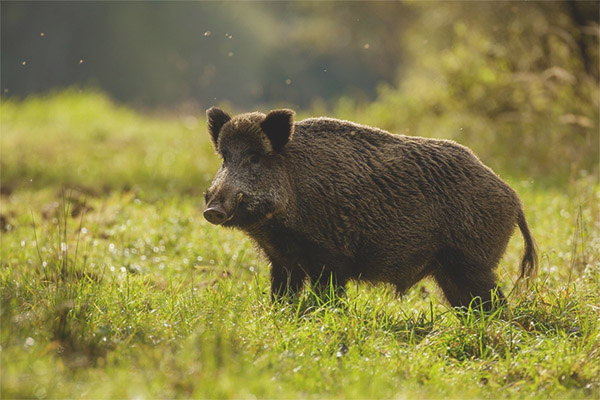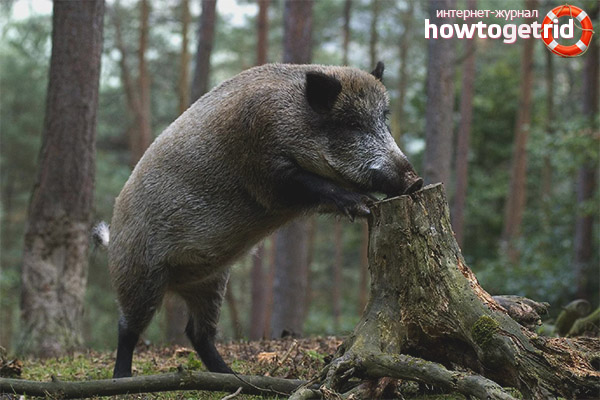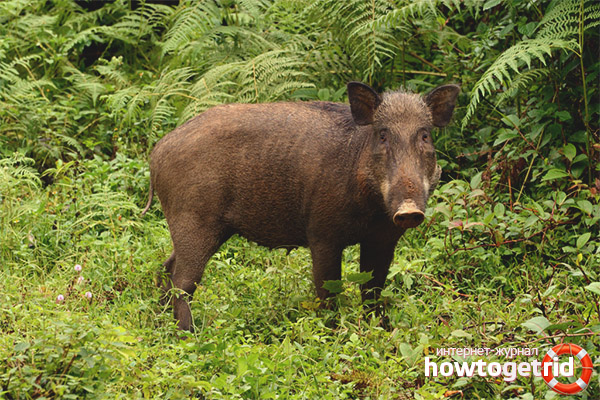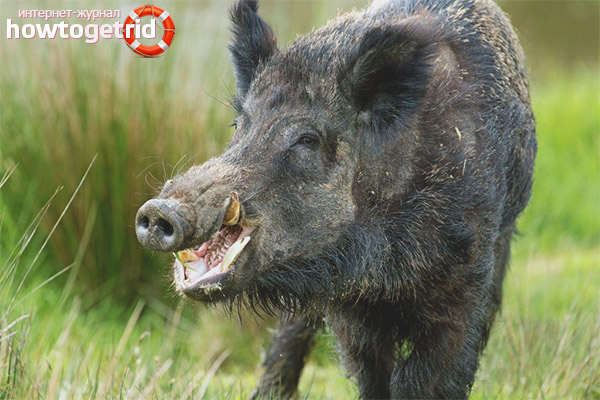The content of the article
Wild boar, which is also called boar or boar - an animal that is distinguished by its strength, speed and omnivorous. He lives in the forest, and his habits are not at all those of a domestic pig. Yes, and they differ in appearance a lot. It will be about this intelligent animal.
Kinds
Wild boars are subdivided into species according to a territorial basis: Indian, Western representatives, Eastern, Indonesian. And there is already a division into nine subspecies: African warthog, Asian boar, European boar, dwarf pig and so on.
Appearance
The boar is one of the largest inhabitants of the forest; the animal is distinguished by its power and strength. The build is large, the legs are short - the height of a wild boar is from 55 to 105-110 centimeters. The body does not differ in large length - from 90 to 180 centimeters, tail up to 25 centimeters long, wide chest, pelvis rather narrow for such a physique.
The skull in the form of a wedge sits on a short, short neck.The muzzle of the beast is decorated with a distinctive feature of pig-like animals - the nose in the form of a penny. Two long canines stick out of the mouth, helping to live in the wild. The length of each reaches 20-23 centimeters. Wild boar weighs depending on age and nutrition - from 60 to 320 kilograms. The average weight is about 120-140 kilograms. Males outwardly differ from females only in size - they are larger and slightly heavier.
Like most wild animals, wild boars are covered with wool, which has the appearance of short bristles, which helps not only to get warm, but also to be camouflaged. On the back, it forms a kind of mane, ending in a crest, which begins to bristle when the animal is excited. With the onset of cold weather under the bristles a warm thick undercoat grows. The color of the bristles depends on the habitat and can be from coal black to light brown.
Distribution area
In ancient times, their habitat was much larger, and due to the fact that people mastered new territories and hunted a lot there, the population of wild pigs decreased markedly. Although the boar could get to the North American territory precisely because of the man, he specifically brought this species there at the end of the 19th century.
Lifestyles and habits
This animal does not see very well, but it has a wonderful sense of smell. The smell of the beast or man can be felt at a great distance.
A wild boar is a gregarious animal, but males prefer to live apart, joining the herd only during the mating period. In total in the herd from 15 to 30 individuals - females, offspring, weak animals and young animals. Usually in the herd for each male there are three females.
The activity of a wild boar manifests itself at dusk. He goes hunting, searching for food and swimming.During the day, he prefers to rest in the reed thickets, or in the marshes, buried among the bushes. There he digs a hole in his fangs and sleeps until sunset.
Only the male protects the territory and protects the female with offspring. Although the female will not give offense to either herself or the children. Let it be smaller in size and the canines are not so long and strong, but it is able to cope with the enemy, crushing him with his weight and pinching his hooves.
Boars are pretty quick, but somewhat clumsy. Great swim and able to overcome long distances. It can go more than 100 kilometers, if there was a fire in the territory of residence. Or in search of food.
Nutrition
The wild boar eats everything, it has no special preferences. It mainly eats food of plant origin, and it doesn't matter whether it is on the ground or underground. Having eaten branches and leaves of the plant, with a strong muzzle, digs up the ground and takes out tubers and bulbs from there, eats up the roots. He eats mushrooms, all kinds of fruit, loves to eat berries, loves acorns. In habitats near humans, often whole herds wander into the fields and destroy potatoes and cereals.
They are very fond of apples, which are also mined in man-made gardens. Of course, causing considerable damage to farmland.
They also eat animal food - snails, toads and frogs, larvae, mice and other rodents, hedgehogs. Meeting on the way the nests of birds nesting on earth, feed on the nestlings nestling. In the autumn, large boars can even bully a hare or a young, weak goat.
With pleasure eat carrion, never pass by.
Breeding
Males reach sexual maturity in the sixth or seventh year of life. In females, it comes much earlier - about 1.5 years. The marriage period (rut) begins in November and lasts until January. Males for marriage comfort returned to the herd. During this period, they acquire protective armor under the skin - the muscle reaches a size of 2-3 centimeters. It is located on both sides and performs a protective function from the attack of the enemy. Including serves as protection against sharp tusks of the contender when wild boars converge, fighting for the female.
During the mating season, this struggle does not stop, the males converge and cause injuries and wounds to each other. But these injuries are worth it - the winner can immediately get several females with whom he will mate.
Pig pregnancy lasts approximately 110-120 days, children are born in mid-April.The female moves away from the herd, builds a den, lining a bed of herbs, leaves, moss and branches, and awaits the appearance of offspring.
In pigs giving birth for the first time, two or three pigs appear, then it gives birth to more - four to five pigs. Although there are cases when born on 10 cubs. Children are born striped, which helps to perfectly mask in the forest.
Cubs live next to their mother, she feeds them with milk for about three to three and a half months. Living together with a parent, young people slowly get acquainted with the habits of adults, learn skills and at the end of feeding mother's milk begin to earn their own food.
At the age of 4.5-5 months, the pigs darken completely and become black in color.
The enemies
These powerful and powerful animals have their enemies. They are all predators that inhabit the forest. But the most dangerous ones are wolves, lynxes and bears, they are very capable of poisoning the life of a billman.
Wolves alone are not able to overcome the boar, so they usually attack the whole pack. It starts with the fact that one of the wolves jumps on the boar and knocks them down, dropping them to the ground.Then the remaining members of the pack rush to the victim.
The lynx, basically, attacks young pigs that have strayed from the herd. She jumps on the neck and back, scratching with claws and teeth, causing wounds from which the chopper dies.
The most dangerous enemy is the largest forest beast - the bear. When attacking, it squeezes with strong paws to such an extent that the animal receives numerous fractures, from which it dies.
Breeding
Planting wild boars at home is very difficult, but it allows you to get delicious meat, a kind of delicacy, which has many useful properties.
Wild boars breed very well in captivity, they are uncapulous, they eat absolutely everything, and they gain weight with fantastic speed. In addition, they naturally have strong immunity, so do not worry that someone from the livestock will die.
What to do when you meet a boar
Boars do not differ excessively aggressive, so they will never attack a person from whom no signs of danger emanate. It’s easier for them to run away when they meet people, rather than start attacking them. Although there are cases of exceptions, for example:
- If the beast is wounded, it doesn’t matter where and when the boar was wounded. In this case, the attack can not be avoided.
- If there was a meeting with a female who cares for small children, the pig will decide that her offspring is in danger and will begin to protect them zealously.
- When a person performs actions or makes sounds that cause anger in an animal, or if a very hungry cleaver thinks that tourists have something to eat (although animals rarely behave aggressively, trying to steal food and food from a person).
If the boar set off in pursuit of a man, then it is hopeless to run away from him, because bats are very fast animals. If there are a number of trees - you need to climb on them and wait for the beast to leave. In this case, one should not shout in his direction and throw any objects. Otherwise, he will get angry more. After some time, the boar gets tired wait and leave. If there is a reservoir not too dangerous for a person nearby, you can try to swim away. After all, this inhabitant of the forest is not swimming as fast as running.
Fangs and hooves can severely damage a person, so avoid direct contact with the boar.
Interesting Facts
- Boars are quite sensitive to temperature extremes. In order not to burn the skin of the sun, they are lying in the dirt, carefully smearing the body. The dried mud crust also serves as protection against the bites of blood-sucking insects.
- During the day, the boar eats about six pounds of food.
- Great damage caused to young wild boar is not only predators, but also natural disasters. Quite a few babies died due to forest fires, floods and floods.
- So that the number of wild pigs is not sharply reduced, people often feed these animals during harsh cold winters. For this purpose, special briquettes are used, consisting of meat and bone nutritious flour or root vegetables - potatoes and rutabaga. Such treats are placed in special places, and the pigs maintain their strength with these gifts.
- Boars are very important that next to their rookery was some kind of reservoir. People got the idea that these animals are unclean. Domestic pigs - maybe. And the wild ones constantly bathe, and they roll in mud only to protect the skin from the sun's rays and the ever-annoying mosquitoes.
- The man learned to use the ability of the boar to rummage in the ground in search of food to their advantage: the French and Italiansteach pigs to look for valuable expensive mushrooms called truffles.
- Mankind has long loved the hunt for wild boars. This is an interesting and rather complicated affair. They hunt in different ways: they chase dogs with dogs, watch them in places where a pig drinks or feeds, and shoots from towers or helicopters.
About how so fiercely furious or cornered boar, tell different stories. There are cases when a tiger that attacked a wild boar was killed by it.
Video: wild boar (Sus scrofa)














To send